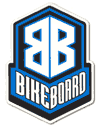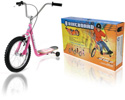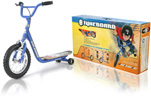The BikeBoard Company
The story of how a company wants to update traditional scooters and bring them to market.

In 2000, scooter-type products caused nearly 10,000 emergency room-treated injuries, according to the U.S. Consumer Product Safety Commission. Ninety percent of those treated were children under the age of 15. Statistics are cold, but watching your child's head ricochet off the pavement is even more so.
"If you hit a rock or a crack in the sidewalk, you'll do a header over the front end," G.M. Davison explained on the potential dangers of the small front wheel on slim-designed scooters. That little front wheel, he noted, was the main engineering flaw.

Sometimes it's not necessary to reinvent the wheel, just reinvent the scooter around that wheel. Oh, and replace the wheel while your at it. For southern California's The BikeBoard Company, that's exactly what they needed Davison to do. With function over fashion in mind, Davison set out to make a better scooter.
"We went through stacks and stacks of drawings and models until finally we ended up with one mononeck frame that would hold up to the heavy pounding and demands that the X-er crowd - the aggressive kids - would go with."

The final design was on the other end of the spectrum from models like the Razor®. The BikeBoard looked towards industrial strength and functionality safe enough for inexperienced riders, but tough enough for the most aggressive. A hybrid of the bicycle, scooter, and skateboard, the final product truly fits its tagline Like "Nothing Else on Wheels©." These two key elements are easily recognizable by the public, making it simple to understand and alleviating any fear of having to learn to ride all over again. Its bicycle wheel and body-style makes it easy to store on any city bike rack. Free of the burden of a kickstand, the BikeBoard is always in an upright position, always ready to ride. This is unlike the smaller scooters often folded up and stored away to collect dust.
"So, the next challenge was, how do you come up with a whole line, not just one product?" In the end, Davison developed an entire line of BikeBoards, including the Tyke, a bike designed for younger children to ride years before they're ready for even a normal bike on training wheels.

"It attracts younger parents to the product, because, of course, kids want to have their own bicycle. The BikeBoard is the transition before you go to a normal bike. It gets the children familiar with motion and more importantly, it keeps them safe."
Three other models fill out the line: The Cruiser, with its "ape hang" handlebars; the Freestyle, for the more adventurous riders; and the Mini.
Throughout the months of development, one additional challenge hung over the Davison team: Creating a patentable product. Despite the already crowded environment of scooter patents, the unique BikeBoard pushed through the opposing forces of the patent universe and the final product received the patent US # D507605 for its distinctive frame design, which lets it ride like a surfboard on pavement. BikeBoarders can carve and trick like never before, making their sport just like the BMXers, surfers, and skateboarders that came before them.
Today, the BikeBoard has taken on a life of its own, being featured by the Gear Guru on national television shows, as well as making appearances on Extreme Makeover Home Edition, American Chopper, and the newly released version of the film The Bad News Bears. The BikeBoard is also being sold by some of America's largest sporting goods and toy store chains, including Dick's Sporting Goods, FAO Schwarz, The Sports Authority, and Dunham's Sports to just name a few. Additionally, it is even selling in overseas markets.
"It's engineered to give you the feeling, characteristics and performance attributes of a skateboard, bike, snowboard, or surfboard. It's capable of many high speed and aggressive maneuvers." —Gear Guru (http://www.gearguru.com)